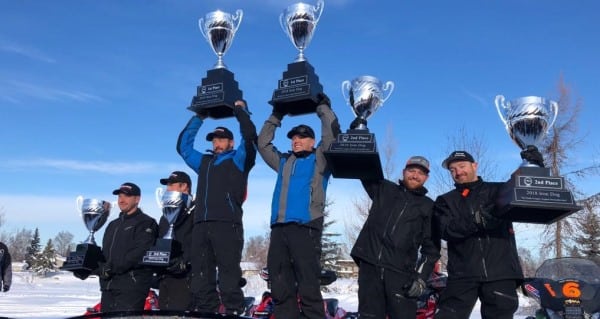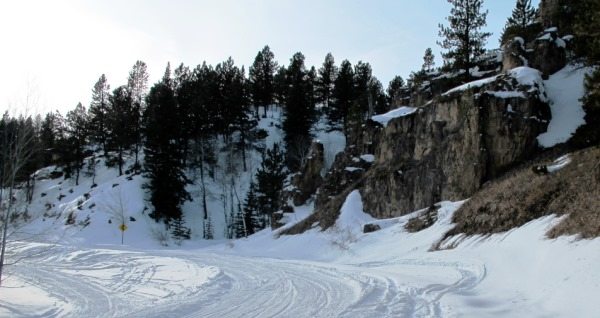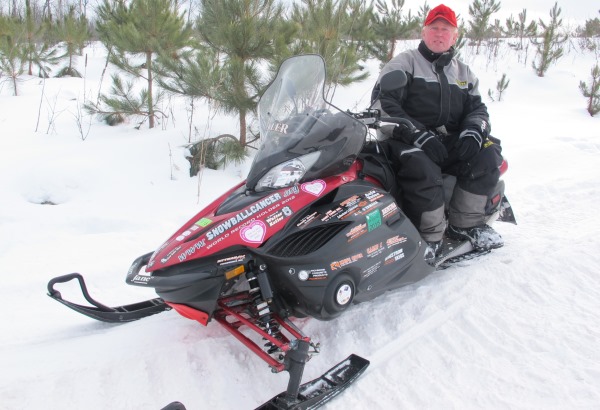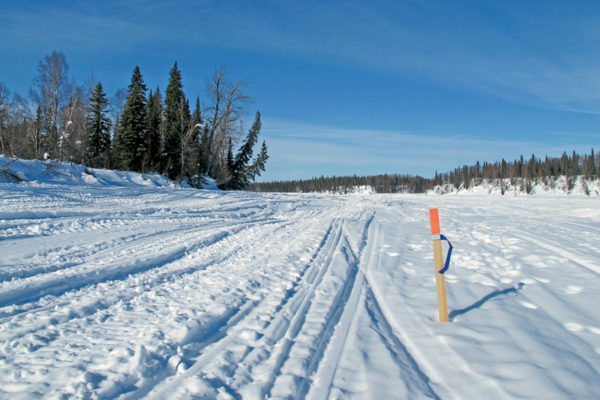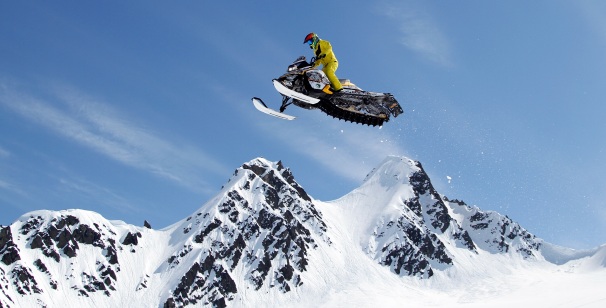Author Lance Woods submitted this story about his fascinating adventure across Alaska. Do you have an interesting story to tell about an adventure of yours? If so, we would love to hear it! Reach out to us at NLongworth@SnowGoer.com, and maybe you’ll be reading the tale of your ride next time!
It was March 1, 2016. I had just spent the past five days driving from Dent, Minnesota, to Manley Hot Springs, Alaska, where I was set to begin a snowmobile expedition across Alaska. The long drive gave me time to unwind from the rigors of organizing and packing for this trek, and mentally prepare for what was ahead. Past experience had taught me that I was in for an emotional roller coaster. There would be days that there would be no better place in the world to be, and days there would be no worse place. There would be days of joy, sorrow, loneliness and many obstacles to test my sanity and ask myself, “Why am I here?” In the end, it’s those seldom days that there is no better place in the world to be that make it all worthwhile.
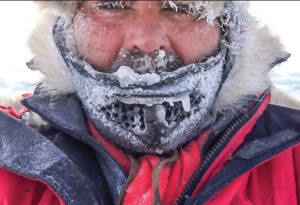
My life has been filled with adventures, and I’m undecided if my adventurist spirit is a blessing or a curse, or maybe an incurable addiction at the least. My most memorable expedition was a 5,500-mile snowmobile traverse across the Canadian Arctic to Baffin Island. Snow machining on the sea-ice amid icecaps of Baffin Island and the emerald green icebergs that had drifted over from Greenland was astonishingly beautiful.
For this trip, Manley Hot Springs was the end of the line for my truck and the start of my three-week solo adventure on a Yamaha Bravo snowmobile while pulling an Inuit-style qamutik tow sled I nicknamed “Aurora.” I checked into the legendary Manley Roadhouse for three nights to get things organized, check out the trail conditions and make a test run up the Tanana River, which was void of snow with lots of overflow.
The adventure was about to begin.
A Rough Start
As I left Manley for my weeks-long expedition on the Bravo I was in hurry mode – probably because I was anxious. I followed the airport runway to the end where I dropped down to the icy slough and then immediately found out Aurora tracks terribly in icy conditions, or on uneven ice, or with a side wind that promotes an uncontrollable jackknife. Twenty miles down the Tanana, the river became snow-covered and Aurora tracked straight and true, so I thought the worst was over. I soon was proven wrong.
Several miles before the Tanana united with the Yukon River, fierce winds had blown away every snowflake, forcing me to the safety of the riverbank. I pointed my Bravo up the steep, 6-foot ice ledge but Aurora had a mind of her own. I felt the rear end of the Bravo pull, and the moment I looked back Aurora yanked the Bravo off the top of the bank and whipped me off like a rodeo bull. The snowmobile and tow sled jackknifed and spun three times, with me sliding on my stomach for 100 yards.
I unhooked Aurora from Bravo and rode it to the high side of the bank. Dilemma: The ice ledge went as far I could see. My only option to get Aurora over this steep ledge was to hook a rope to its hitch and pull her by hand. That was easier said than done. After what seemed like hours of pulling, grunting and growling, Aurora was on the bank. I traveled onward with a much higher degree of caution.
Soon after leaving the crash site, I saw in the distance a thick, dirty haze hugging the river’s horizon. It was a blend of mainly dirt and snow, drifting like a desert storm where the Tanana and Yukon rivers meet. As I entered the dark abyss, a stiff side wind pushed Aurora wherever it desired on the snowless ice. The wind eased up as I neared the far side of the Yukon River and the village of Tanana. The river ice was badly broken, forcing me to follow a narrow ice shelf on the edge of the bank, where the snowmobile and tow sled jackknifed again.
Frustrated, exhausted and with darkening skies, it was time to set up my first campsite. I had to empty Aurora and portage all contents up onto the bank. I rode the Bravo up and then manhandled Aurora up the ice shelf.
On High Alert
The next few days were spent traveling down the mighty Yukon River, but local thin ice warnings had me on high alert. Snow conditions improved and made my tracking issues with Aurora bearable, which lightened my mood. Upon nearing the village of Ruby, ice became barren of snow and the Bravo and Aurora began dancing like a slithering snake. A brief moment later, I heard a loud thud. I looked back to find Aurora had slid sideways, caught an ice block and flipped upside down. The Bravo’s hitch was broken and one of Aurora’s plastic runners was half ripped off. I made repairs and got back to work.
I ate an oatmeal lunch while enjoying my view at picturesque Ruby before heading down river again. From there, my luck went downhill. Many times the snowmobile and Aurora jackknifed on the Yukon’s uneven, glare ice. The following became the routine: Jackknife Bravo and Aurora. Untether them. Ride Bravo onto level ice. Hook rope between Aurora and Bravo. Pull Aurora onto level ice. Re-attach Aurora to Bravo’s hitch. Carry on. I was starting to seriously dislike Aurora.
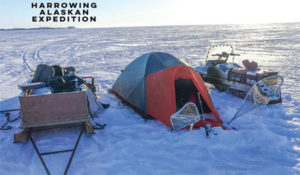 Conditions changed again as the river’s horizon took on a dirty, heavy haze and a blustery side wind began to pelt me like piercing knives. Dirt from an island and the riverbanks saturated the windblown ice with fine sand, which made the surface like 100-grit sandpaper. The Bravo had all it could do to pull itself and Aurora. This continued for several miles but the wind subsided after I rounded a bend and snow blanketed the river once again.
Conditions changed again as the river’s horizon took on a dirty, heavy haze and a blustery side wind began to pelt me like piercing knives. Dirt from an island and the riverbanks saturated the windblown ice with fine sand, which made the surface like 100-grit sandpaper. The Bravo had all it could do to pull itself and Aurora. This continued for several miles but the wind subsided after I rounded a bend and snow blanketed the river once again.
When I arrived at the village of Galena, locals recommended that I take a portage on the north side of the river to get to Kaltag, 100 miles downriver. The portage consisted of miles and miles of connecting swamps dotted with gigantic beaver houses.
Kaltag is a typical Alaskan village. Boasting a population of 200 people, it’s made up of rustic houses and log cabins nestled on the bank of the Yukon River. I topped off my jerry cans there and then headed toward Unalakleet, 95 miles away. The route cuts cross-country through the thick bush, crossing multiple creeks and streams on the roughest trail I had ever encountered. Three- to 4-foot-deep moguls tested the durability of Aurora and made for 20 agonizing miles. The farther west I went, tree cover became sparser as the landscape transitioned to high rolling hills.
Lap Of Luxury
Almost a week into my adventure, a structure popped into view and I became ecstatic about the possibility of a night’s stay in a warm cabin. Closer inspection, however, caused my heart to sink. It was a broken-down structure on a twisted frame with busted-out windows and a door hanging off its hinges.
Disappointed, I traveled onward only to be even more disgusted just a few hundred yards down the trail. A quick S-turn on the heavily timbered river’s edge proved to be too tight for the 12-foot-long Aurora – she was wedged tight into the tree trunks. I unhooked the Bravo and attempted to manhandle Aurora out of this bind, but she proved to be too heavy. I unloaded equipment from the lazy sled and then, once free of the trees, I reloaded it and angrily shoved her onto the river and yelled, “I hate you! You are now renamed Sidewinder!”
Qamutiks like Sidewinder are made for traveling across barren lands and are supposed to excel in hauling heavy loads because they span rough, windblown drifts. This qamutik was out of its element, though. Soon the dense forest began to open up and suddenly my sour mood got a dose of sugar.
Like a castle in a fairy tale, the most beautiful log cabin appeared through the clearing. The Bureau of Land Management (BLM) provides such survival shelters for public use, and this one included a woodstove, Coleman lantern and stove, Swede saw, ax and built-in wood bunks. With my spirits lifted, I started a fire and dried my equipment.
After a great night’s sleep, I decided to stay one more day, which was spent cutting firewood, exploring the area and giving my body a break. The next morning, I headed back into the unknown.
More Adventure Awaits
As I ventured toward the coastal village of Unalakleet snow became increasingly scarce, and the last several miles to the village including crossing large, snowless sections of land. I made camp near a small lake a few miles from town and took photos of the awe-inspiring landscape surrounding me. The sparsely treed coastal mountains crept to the water’s edge. A rainbow of colors accented my surroundings.
In the morning I rode into Unalakleet for fuel, and friendly locals reported that there would be little or no snow for the first 20 miles north, causing me to worry if the Bravo could handle more bad conditions. I left Unalakleet and crawled my Bravo across the barren landscape – a brown tundra with the beautiful blue ocean to my west and white, snow-laden mountains to my east. As I looked to the north I saw my only option onward: up a long, steep hill. I clamped the throttle to the handlebar and hit it as hard as I could. About 100 feet from the hill’s crest the one-lunger couldn’t pull anymore. I locked the parking brake and swiftly tied a rope from Sidewinder to a stout tree 50 feet uphill before gravity could pull everything downhill into a pile of shrapnel.
I unhooked the Bravo and rode it to the crest, carried up heavy items from the tow sled, and then anchored one ratchet strap to a tree uphill and the other end to Sidewinder’s hitch and used them as a makeshift come-along, gaining about 2 feet of progress before retying the safety rope and losing a foot in rope stretch. This process took three hours.
After reloading my supplies, I headed off for the promised land of snow. It would not come easy, though, as there would be more snowless miles and three more jackknifes. As the sun set, I stopped to make camp – exhausted. A quick glance at the odometer revealed 26 miles of progress that day, a distance I could have walked in that time.
March 12th took me into the village of Koyuk, a stop for the famous Iditarod dogsled race that I stayed to observe.
The Devil’s Triangle
The next morning I was aimed toward Kotzebue, a two-anda- half-day trip involving a variety of terrain including frozen rivers, sea ice and long gradual treeless mountains. I found this transition to tundra very alluring with its vast openness and eye-appealing vistas. The Sidewinder performed flawlessly in this snow-filled landscape, conditions were good, equipment was working well, scenery was spectacular and it truly was the best place in the world to be on that day.
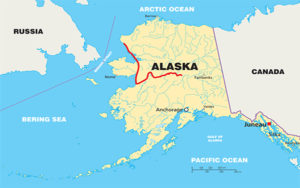
Cape Thompson is 130 miles north of Kotzebue, or 50 miles north of the Kivalina. I was informed that if there is so much as a breeze in Kivalina I shouldn’t even think about attempting the Cape due to the excessive winds created there. During my journey, I was given stern warnings to stay off the sea ice. I was also told that the Cape would be the most challenging part of my adventure. All of this left me a bit unnerved.
The route to Kivalina led across Kotzebue Bay to the mainland’s tundra and up the village’s ocean side. Here I anxiously sought information, fuel and more horror stories. A local elder told me that people rarely venture up that way until April. I was informed the last pale face adventurer to travel through there disappeared, and his body had not been found. The fuel attendant warned me of the Cape’s temperament, and a bystander stated there have been stories of snow machines and riders being uprooted and blown into the sea. In my mind I downplayed the stories to settle my nerves, knowing how stories can become exaggerated.
The forecast for Kivalina called for 35 mph winds for the next two days, but at that time there was no wind at all. This could be my window to assault the Cape, I thought. I stowed my jerry cans and proceeded north.
Ten miles up the coast the wind hit me abruptly. It was time to make camp and wait for the wind to subside. The wind howled deep into the night. I joyfully awoke to dead silence. Apparently the front had blown through, I thought, so it was time to get this notorious Cape behind me.
As I inched north the terrain soon became rough and windblown, exposing long stretches of bare rocky beach. I saw a high plateau with what looked to be an ominous dark cloud extending out to sea. It became apparent that high winds were billowing clouds of drifting dirt and snow off the plateau, mixing with the black water vapor off the open ocean.
With visibility gone, I rode near the accumulated pack ice along the beach for a reference to navigate. Just beyond the beach over the ice rubble I made out the greenish tint of seawater a few yards away. Conditions continued to deteriorate and the Bravo’s engine was groaning, so I looked back and found the fully loaded Sidewinder has blown onto its side. Getting off of the Bravo, I found it nearly impossible to stand in the 50 mph winds. I tried to right the Sidewinder but it didn’t even wiggle, so I removed heavier items, using extreme care so essential gear didn’t blow into Russia.
After making things right again with my trailing qamutik, I continued. The mountains began to push me tight against the beach, forcing me onto a 20-foot-wide ice shelf where I ran into more trouble with Sidewinder. Seven trips through soft snow and unforgiving winds were required before Sidewinder could be manhandled up the steep slope. Two hundred yards later I repeated the same arduous tasks.
Totally exhausted and my face numb from frostbite, I told myself I cannot do this one more time today. I asked myself, “Why am I here?” and had no good answer. But I forged on and soon the mountains pulled back from the coast and I had to travel over land without the windbreak the mountains provided. I knew I must find shelter before becoming too exhausted.
I had heard rumors of an old cabin before the Cape that I could use to get out of the weather. Through the thick, milky ground blizzard I again saw what resembled a cabin. Was it a hallucination? No! Ecstatic, I yelled in celebration before parking on the leeward side of the cabin. The cabin’s door was jammed wide open with a 4-foot diameter, rock hard snowball. A layer of snow covered everything, and it was beautiful! I quickly catapulted my gear into the cabin and got some much-needed nourishment. Going in I had noticed fresh fox tracks inside the cabin. And, being deep into polar bear country, I chambered a slug in my 12-gauge shotgun to ensure a good night’s sleep.
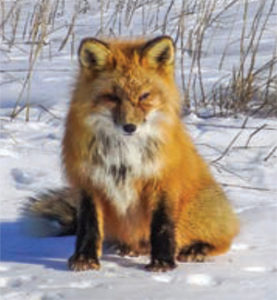
The next morning was blustery but the wind had subsided enough to let me see my surroundings, and realize the Cape was but a half-mile north. I also saw that a large, rocky cliff meets the ocean and a narrow strip of sea ice separates the cliff from the water. Inland as far as the eye can see are coastal mountains, a natural barrier between me and the village of Point Hope 30 miles away.
Folks in Kivalina told me that to reach Point Hope, I needed to find an old ATV trail and follow it up the mountain and down the other side. Asked if they thought my Bravo was capable of pulling a qamutik up the path, they responded, “Hit ’er hard!” When I found the deserted trail my heart sank because it was too steep and too rocky for my low-powered snow machine and tow sled.
I unhooked Sidewinder and rode the Bravo up the mountain. Snow became scarce and rocks clanged against my skis. On top there was a long, flat plateau covered with fist-sized rocks. Seeing that this wasn’t a viable option, I went back down the mountain and began looking for another way over the top. I traveled inland and looked for a way over, only to be thwarted by steep ravines time and time again. The Cape had conquered me. I had no choice but to turn back. After traveling 1,100 miles, I was forced to turn around. My expedition was over.
Disappointed, I began my return trip to Kivalina and thereafter Kotzebue. Within minutes after turning back, my trusty Bravo began cutting out and the engine died. Staying positive, I screwed in a fresh spark plug. The Bravo started, cut out and died again. After some troubleshooting, I determined the Bravo wasn’t getting spark. As I went to change the ignition coil I noticed the screws holding it in place were loose. I tightened the screws, yanked on the pull cord and was back in business. The Cape truly is the Devil’s Triangle of the north. There was no worse place in the world to be.
Sayonara, Sidewinder
As I sat an extra day in my hotel room in Kotzebue with my feet up and sipping on a cold beer, I couldn’t decide whether to burn Sidewinder or sell it. The next morning I dragged her to the grocery store and began panhandling. A half hour later, I had a victim. He gave me $350 for it, and I shed no tears when Sidewinder was pulled out of my sight.
That afternoon, I received word that my snowmobile arrived at the airport in Anchorage where I would pick it up to haul it back to Minnesota. The drive home gave me plenty of time to think about what I could have done differently. Will I return and try again to conquer the Cape? Maybe, but not with the Bravo or that nonsensical qamutik!
Editor’s Note: Every issue of Snow Goer magazine includes in-depth sled reports and comparisons, aftermarket gear and accessories reviews, riding destination articles, do-it-yourself repair information, snowmobile technology and more! Subscribe to Snow Goer now to receive issues delivered to your door 6 times per year for a low cost.

